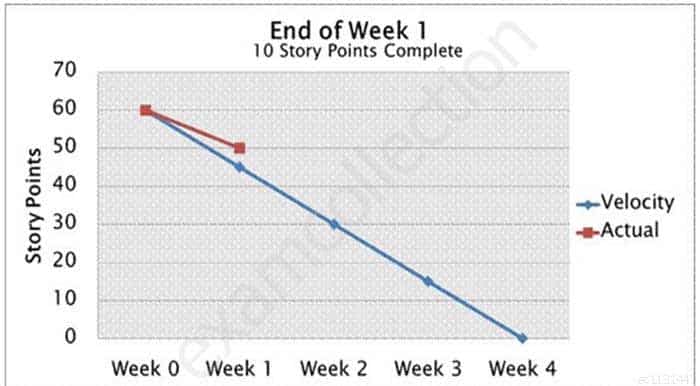PMI-ACP : PMI Agile Certified Practitioner : Part 20
-
Based upon this Burndown chart, is this project ahead of schedule or behind schedule?

PMI-ACP PMI Agile Certified Practitioner Part 20 Q01 028 - Ahead of schedule
- Behind schedule
-
Which of the following occurs in the first Sprint?
- Create a project plan
- Develop a shippable piece of functionality
- Complete your reference architecture
- Develop the Product Roadmap
-
With multiple Scrum teams, you should have a separate product backlog.
- True
- False
-
What is the best definition of “Done”?
- Whatever will please the Product Owner
- It is determined by the Scrum Master
- The prodct has passed QA and has all of the required release documentation
- The definition of “Done” is one that would allow the development work to be ready for a release.
-
Which of the following does NOT describe Scrum?
- Simple to understand
- A lightweight framework
- Difficult to master
- A process or a technique for building products
-
Scrum is NOT:
- A set of software project management principles
- Founded on empirical process control theory, or empiricism
- A process framework used to manage the development of products
- Designed for static requirements
-
Which of the following is NOT part of the Scrum Framework?
- Roles
- Events
- Characteristics
- Artifacts
-
What are the three pillars of Scrum?
- Transparency, Inspection, and Adaption
- Transparency, Inspection, and Empiricism
- Transparency, Acceptance and Adaptation
- Retrospectives, Inspection, and Adaptation
-
What does Scrum mean by Transparency?
- Users can perform code reviews at any time
- Documentation is available to anyone
- All team members sit in a visible location
- The process is understandable by all stakeholders
-
When does Adaptation occur in Scrum?
- At the Sprint Review
- During Sprint Planning
- In the daily Scrum
- At all four formal Scrum events
- As Part of the Sprint Retrospective
-
Who is NOT part of the Scrum Team?
- Product Owner
- Scrum Master
- Customer
- Development Team
-
A cross-functional team in Scrum consists of which types of team members?
- A specialist in QA
- An architect
- A release manager
- Anyone with the skills to accomplish the work
-
Scrum is both an iterative and incremental Agile process.
- True
- False
-
When does Inspection occur?
- Throughout the Sprint
- Only at the end of the Sprint
- Whenever the Product Owner wishes
- Frequently, but not so often that it gets in the way of work
-
The Product Owner is the sole person responsible for managing the Product Backlog.
- True
- False
-
Who is responsible for maximizing the value of the product?
- Senior Executives
- The Product Owner
- The Scrum Master
- The Development Team
-
The Product Owner does not have to be a single person but may be a committee or a shared responsibility between multiple individuals.
- True
- False
-
No one, not even the Scrum Master, tells the development team how to build the product.
- True
- False
-
The development team should have a lead developer to ensure the work is properly executed.
- True
- False
-
The optimum size of the Scrum Team is:
- 7
- Between 3 and 9
- 5
- It depends
Subscribe
0 Comments
Newest